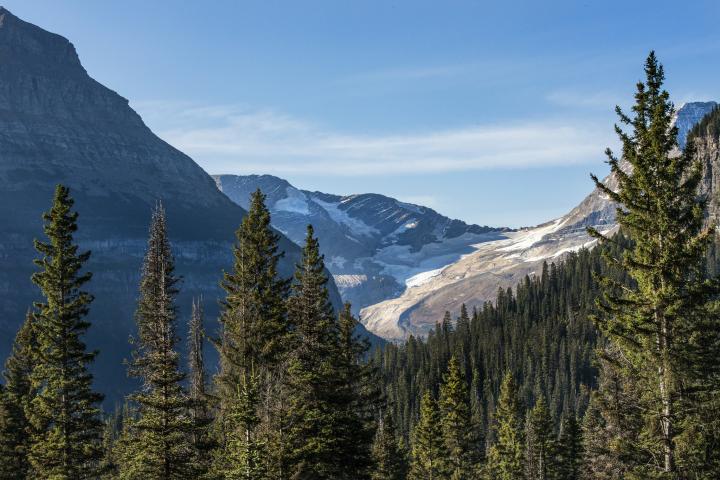Join the Almanac in a coast-to-coast exploration of America’s most beloved national parks and historic sites. This time, we visit Glacier National Park in northern Montana, where rocky peaks and stunning sights abound.
Glacier National Park
The “Crown of the Continent” is one of the wildest, most pristine places left on earth. The park is home to endless peaks, valleys, lakes, and, of course, glaciers. Unfortunately, what makes this landscape so unique is disappearing as a result of climate change; of the 150 glaciers that were active at the park’s founding in 1910, only 25 remain.
Our game plan was to take the shuttle up the famous Going-to-the-Sun Road to Logan Pass, the road’s highest point (6647’). The first shuttle was set to leave at 7, so we were out the door bright and early, and arrived just in time to catch the express to the Logan Pass Visitor Center.

Logan Pass. Photo Credit: National Parks Service/Tim Rains
The sun was still low in the sky, shedding soft, orange light on the forest and the lakes when we left the Apgar Visitor Center near Kalispell. Construction began in 1921 and it took 11 years to build the road. There is no shoulder in many places and the drops are steep—the view of snow-capped mountains is worth it, though, as long as you don’t look down.
Due to the unusually active fire season prior to our visit, it was the first day in about a week with clear skies. Even so, the sky grew hazy by around 1 in the afternoon. This didn’t dissuade us, though, and we started our adventure with the Hidden Lake nature trail, a short hike leaving Logan Pass. We didn’t make it all the way to Hidden Lake, but the higher we climbed, the more spectacular the vista of meadows, mountains, and glaciers.
After the hike, we remounted the shuttle bus to check out the eastern side of the park. At the Sun Point Nature Trail, we got off for a 0.2-mile loop, a picnic lunch, and a breathtaking view of St. Mary’s Lake. Then we headed back west to Jackson Glacier Overlook, to catch a glimpse at one of the few remaining glaciers in the park.

Jackson Glacier, 2015. Photo Credit: National Parks Service/Tim Rains
When we got back to Logan Pass, the visitor center was packed with long-distance backpackers and day-trippers like us. Then, on our way back to Apgar, we stopped at the Cedars Trail, another short, flat loop that takes visitors through an ancient cedar forest on the banks of Avalanche Creek.
Travel Tip: The Going-to-the-Sun shuttle is operated by the park and is free of charge for visitors who have paid the entrance fee ($12 for individuals or $25 per car). It follows the road from Apgar in the west of the park and St. Mary’s in the east, stopping at various points along the way. It’s an easy and convenient way to see the park; you can hop off at any of the stops, do a short loop hike, and hop back on. The other bonus is that you won’t have to worry about parking.
Learn More
Visit the Glacier National Park website for more information on visiting the park! Then check out the rest of our national park and historic site articles to see where to go next.











